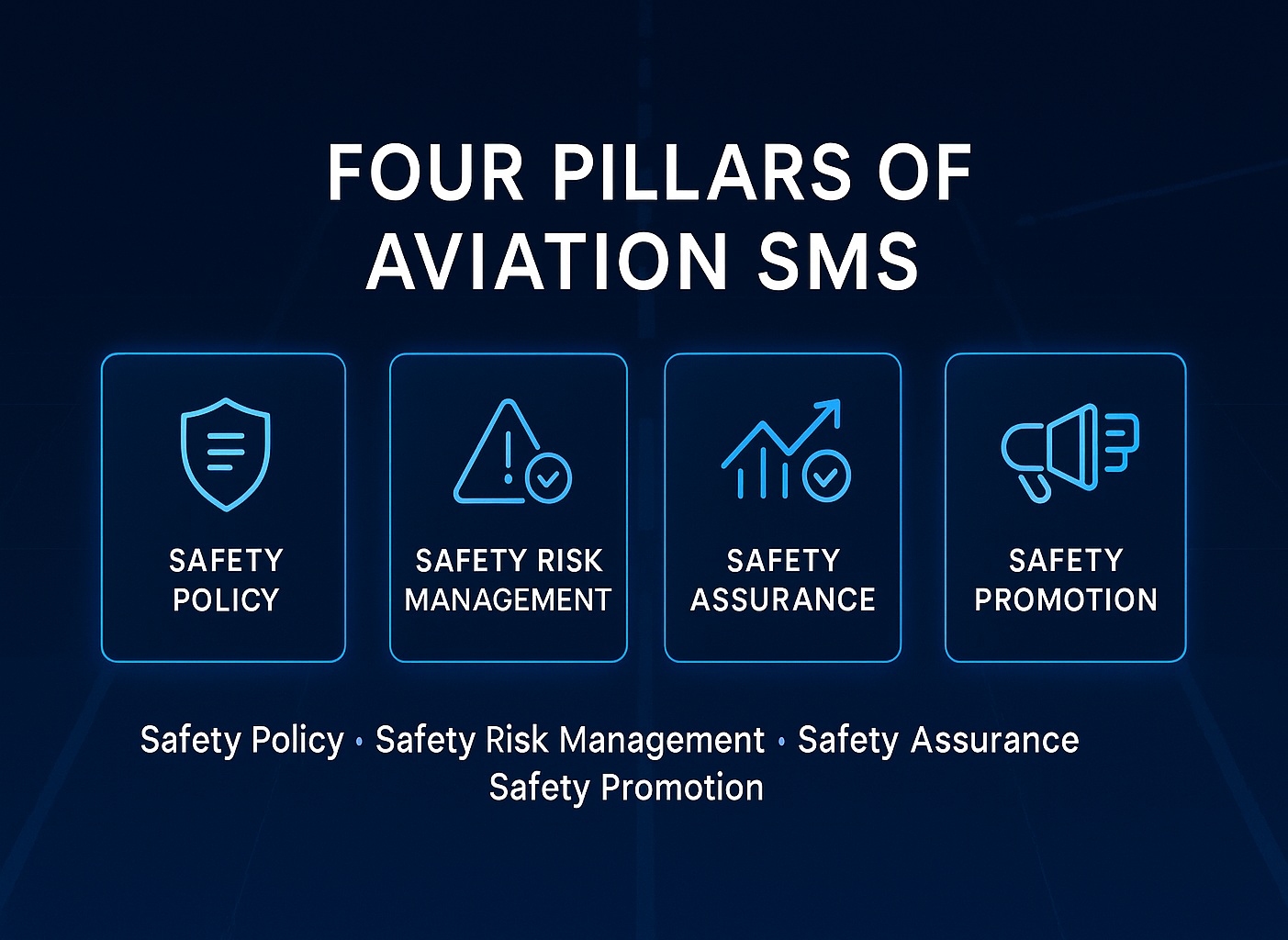About this guide: Compiled for operators, flight schools, MROs, airports, safety leaders, and organizations using widely adopted guidance from ICAO Doc 9859 and major CAAs. Edited for clarity and direct application.
Audience: Accountable executives, safety managers, chief pilots, DOMs, and training managers.
Standards: Plain language, action-oriented, sources aligned with industry practice.
What are the four pillars of SMS? Safety Policy, Safety Risk Management, Safety Assurance, Safety Promotion.
- Safety Policy and Objectives: leadership commitment, roles, ERP, documentation
- Safety Risk Management: hazard identification, risk assessment, mitigation
- Safety Assurance: monitor performance, manage change, improve the system
- Safety Promotion: training, safety communication, culture building
Callout: If nobody owns a control, it is not a control. Assign a named owner and a review date for every mitigation.
| Pillar | Elements | What this means | Quick action | Owner | Review cadence |
|---|---|---|---|---|---|
| Safety Policy and Objectives |
Management commitment
Safety accountabilities
ERP coordination
SMS documentation
|
Direction, resources, roles, emergency readiness. |
Publish a signed safety policy and name the accountable executive.
Run a quarterly ERP drill and centralize SMS docs.
|
Accountable ExecutiveSafety Manager |
Quarterly |
| Safety Risk Management |
Hazard identification
Risk assessment and mitigation
|
Find hazards, rate risk, set controls. |
Launch a 2 minute report form and adopt a risk matrix.
Record controls with owners and due dates.
|
Safety ManagerOps leads |
Monthly |
| Safety Assurance |
Performance monitoring
Management of change
Continuous improvement
|
Verify controls work and trend the right way. |
Define 3–5 SPIs and apply change checklists.
Track findings and corrective actions.
|
Safety ManagerQA |
Monthly to quarterly |
| Safety Promotion |
Training and education
Safety communication
|
Build skills and a reporting culture. |
Map training by role.
Send a monthly safety note with one lesson and one action.
|
TrainingSafety |
Monthly |
1) What is Safety Policy in SMS?
Answer: The leadership framework that sets safety direction, resources, roles, and emergency readiness so the other pillars can function.
Do this now
- Publish a signed safety policy and brief every new hire during onboarding.
- Name the safety manager and alternates with clear decision rights.
- Coordinate and test an Emergency Response Plan with a simple tabletop exercise each quarter.
- Keep your SMS documentation where crews already work, for example, the ops portal or EFB.
2) What is Safety Risk Management?
Answer: The process to identify hazards, assess risk, and implement controls using reactive, proactive, and predictive methods.
Do this now
- Offer an anonymous, mobile-friendly hazard report that takes under two minutes.
- Use a simple risk matrix and a change checklist for new routes, aircraft, vendors, or procedures.
- Tie every accepted risk to a specific control, a named owner, and a review date.
3) What is Safety Assurance?
Answer: The verification system that monitors safety performance, manages change, and drives continuous improvement.
Do this now
- Pick 3–5 SPIs you can measure, for example, unstable approaches, maintenance rework, runway incursion precursors. Review monthly.
- Track findings and corrective actions in one system and close the loop with reporters.
- Conduct a post-implementation review after changes to confirm that the risk has been mitigated.
4) What is Safety Promotion?
Answer: Training and two-way communication that build skills and culture so reporting stays active and improvements stick.
Do this now
- Map training by role. Leaders need decision-making and accountability training. Line staff need hazard spotting and reporting skills.
- Send a short monthly safety note with one data point, one lesson, and one action. Highlight fixes that came from employee reports.
The 12 elements of SMS at a glance
- Management commitment and responsibility
- Safety accountabilities, including an accountable executive
- Emergency Response Plan coordination
- SMS documentation
- Hazard identification
- Risk assessment and mitigation
- Safety performance monitoring and measurement
- Management of change
- Continuous improvement of the SMS
- Training and education
- Safety communication
- Identification of key safety personnel and roles
Quick implementation checklist for small ops and flight schools
- Publish and brief your policy this week and schedule an ERP drill.
- Launch reporting with QR codes in hangars, cockpits, and classrooms.
- Set three SPIs, review monthly, and post results on the ops board.
- Train to roles using short scenarios and share one improvement every month.
Q&A
What are the four pillars of SMS in aviation?
What are the 12 elements of SMS?
What is Safety Risk Management in SMS?
What is Safety Assurance in SMS?
Bottom line
An effective Safety Management System is a living process. Use the four pillars of SMS and the twelve elements to find hazards early, control risk to an acceptable level of safety, verify performance, and keep teams trained and engaged. Start small, improve often, and make the system visible in daily operations.

